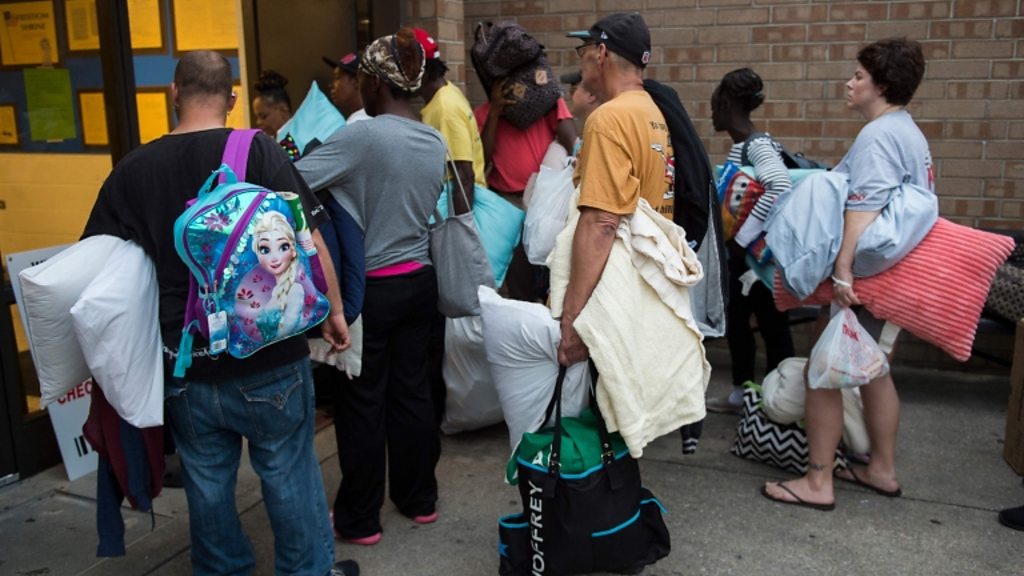US East Coast residents are running out of time to flee before Hurricane Florence batters the region, officials have warned.
The category three storm with 125mph (205km/h) winds is forecast to make landfall early on Friday.
Up to 1.7 million people have been ordered to evacuate across South Carolina, North Carolina and Virginia.
South Carolina authorities have turned four motorways into one-way routes away from the coast to speed the exodus.
On Wednesday, Georgia declared a state of emergency, following the Carolinas, Virginia, Maryland and Washington DC.
A National Weather Service forecaster said: “This will likely be the storm of a lifetime for portions of the Carolina coast.
“And that’s saying a lot given the impacts we’ve seen from Hurricanes Diana, Hugo, Fran, Bonnie, Floyd and Matthew.
“I can’t emphasise enough the potential for unbelievable damage from wind, storm surge and inland flooding with this storm.”
Jeff Byard, of the Federal Emergency Management Agency, said: “This is going to be a Mike Tyson punch to the Carolina coast.”
North Carolina Governor Roy Cooper warned that “disaster is at the doorstep”, and “tens of thousands” of buildings may be flooded.
Image copyright Getty Images
A National Hurricane Center (NHC) plane flying inside the storm found that pressure is continuing to drop, indicating its strength may still be growing.
The storm was downgraded to category three on Wednesday afternoon, but officials say it is still an “extremely dangerous major hurricane,” that is likely to cause severe damage.
Waves measuring 83ft (25m) tall were recorded at sea on Wednesday morning.
Image copyright Getty Images
But while many coastal residents have complied with mandatory evacuation orders, others are boarding up their homes and vowing to ride out the storm.
In other developments:
- Hurricane Florence could wreak more than $170bn (£130bn) of havoc and damage nearly 759,000 homes and businesses, says analytics firm CoreLogic
- North Carolina farms are moving livestock to safety. In 1999, Hurricane Floyd left hundreds of thousands of dead hogs and chickens floating in floodwaters in the state
- Nearly 1,000 prisoners in South Carolina will not be moved from their cells, despite a mandatory evacuation order in the area. “In the past, it’s been safer to leave them there,” said a state department of corrections spokesman
- There are fears for wild horse herds in North Carolina’s Outer Banks, but experts say these equines can sense bad weather coming and head to higher ground
In a video posted to his Twitter account on Wednesday, US President Donald Trump warned residents in Florence’s bullseye to heed official warnings.
“Get out of its way, don’t play games with it,” said Mr Trump. “It’s a big one, maybe as big as they’ve seen, and tremendous amounts of water.”
“Bad things can happen when you are talking about a storm this size. It’s called Mother Nature. You never know, but we know. We love you all, we want you safe.”
What makes Florence so dangerous?
Forecasters say the storm poses such a threat because it is expected to slow down and hover for nearly three days over the Carolina coast, before dipping south towards Georgia.
It is forecast to bring 20-40in (50-100cm) of rain and life-threatening storm surges of up to 13ft.
Hurricane force winds will emanate up to 70 miles from the centre of the storm, say meteorologists, meaning the impact may be felt on shore well before Florence makes landfall early on Friday.
National Hurricane Center Director Ken Graham warned that rivers up to 40 miles inland may flood.
Mr Graham said the Pamlico and Neuse rivers in North Carolina will see their flows “reversed” as storm surges push water back inland.
He added that half of fatalities during hurricanes are caused by storm surges, and another quarter of deaths are due to inland rains and flooding.
Image copyright Getty Images
Is global warming to blame?
The relationship between climate change and hurricanes is a complex one.
Warmer seas power hurricanes. So as the temperature of ocean water goes up, we might expect the intensity of hurricanes to increase in future.
A hotter atmosphere can also hold more water, so this should allow hurricanes to dump more water on affected areas.
But there are so many factors that contribute to these rare events, it has been difficult to tease out clear trends from the data.
Image copyright EPA
Image copyright Getty Images
Are you in the area? How are you preparing for the hurricanes? Let us know by emailing haveyoursay@bbc.co.uk.
Please include a contact number if you are willing to speak to a BBC journalist. You can also contact us in the following ways:
- WhatsApp: +447555 173285
- Tweet: @BBC_HaveYourSay
- Send pictures/video to yourpics@bbc.co.uk
- Upload your pictures/video here
- Send an SMS or MMS to 61124 or +44 7624 800 100
- Please read our terms and conditions and privacy policy
Or use the form below








